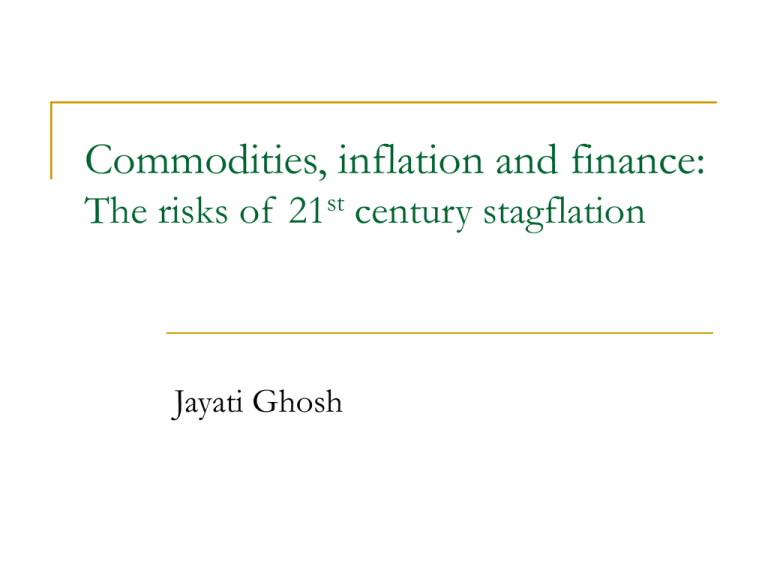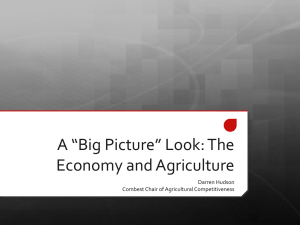Commodities, inflation and finance: The risks of 21 century stagflation Jayati Ghosh
advertisement

Commodities, inflation and finance: The risks of 21st century stagflation Jayati Ghosh Dramatic volatility in global commodity prices. Unprecedented volatility of global commodity prices in 2007-08, first rising then falling. Widely predicted that global economic crisis would dampen such prices. But recent revival of prices especially in some commodities. These price increases are most marked in food and fuel. These recent price changes did not and do not reflect real demand and supply imbalances Financial activity (index investors) mostly responsible for these dramatic price movements. Commodities emerged as an attractive alternate investment avenue for financial investors from 2003 and especially 2006, when the US housing market showed the initial signs of its ultimate collapse. This was aided by financial deregulation that allowed purely financial agents to enter such markets without requirements of holding physical commodities. This generated a bubble, beginning in futures markets that transmitted to spot markets as well. Recent data indicate a new price surge From mid 2008 commodity prices started falling as index investors started to withdraw. Another bubble now: Most important commodity prices have been rising from early 2009. Price increase between Dec 2008 and Dec 2009: 16% for all food (sugar 105%), 96% for metals, 110% for oil. But global demand and supply for most commodities remains broadly in balance; for some, both output and stock holding have increased. However, longer term supply issues are important for food and other agricultural commodities because of policy neglect and persistent agrarian crisis. Negative impact on developing countries Because they are the result of financial activity, such price increases typically do not benefit the direct producers resident in the developing world. But they cause huge damage to consumers of food and other essential items, as the prices of necessities increase even as employment and wages continue to languish. They can also generate cost-push inflation even in a context of slow economic activity. Food prices especially adverse: they did not fall in most developing countries even when global food prices were falling. Past stagflation Past stagflation (1970s) was associated with costpush inflation related to oil price shock and wage increases, within context of low interest rate policy in the wake of recession. The underlying processes were national and global conflicts over income shares. This was eventually resolved by monetarist policies that suppressed real wages and led to falls in primary commodity prices. New form of stagflation today Arguments about the threat of stagnation that are based on excessive government deficits and loose monetary policy are wrong. But the threat comes from another quarter: the continuing involvement of financial speculators in commodity markets, who drive up futures and (indirectly) spot prices. This continues because commodities are seen as “safe havens”, and because inflationary expectations about some commodities persist. This can generate sharp commodity price rises even with weak global recovery, and generate cost push pressures even with large excess capacity in manufacturing. Global output recovery weak and likely to be reversed Basic problems in financial sector still not addressed (and now real estate, sovereign debt issues) and increased risky behaviour because of moral hazard of bailouts. Policy response has been to encourage renewed bubbles based on earlier growth model. US cannot be engine of global growth in the immediate future. Weak employment recovery so sources of new demand constrained. Sever procyclical policies still being imposed on BOP constrained economies by IMF and other international agencies. Dealing with the new stagflation Because this is different in nature, broad macro policies like raising interest rates will be counterproductive. Instead the focus has to be on specific actions to control commodity prices. The most important immediate action is regulation of finance with respect to commodity markets. Strategies include banning financial players from involvement in commodity futures markets and ensuring cheaper access of developing countries to supplies of such commodities. Commodity boards, buffer holdings and other measures to stabilise prices also important. Inflation is still all about income distribution This projected stagflation would reflect the attempt of the global financial class to increase its share of global income, even in the wake of financial crisis. Most of the declining share would be of wage incomes especially in the developing world. Therefore attempts to resolve this also require a reduction of the political power of finance – but this may not occur without even more extensive crisis.



